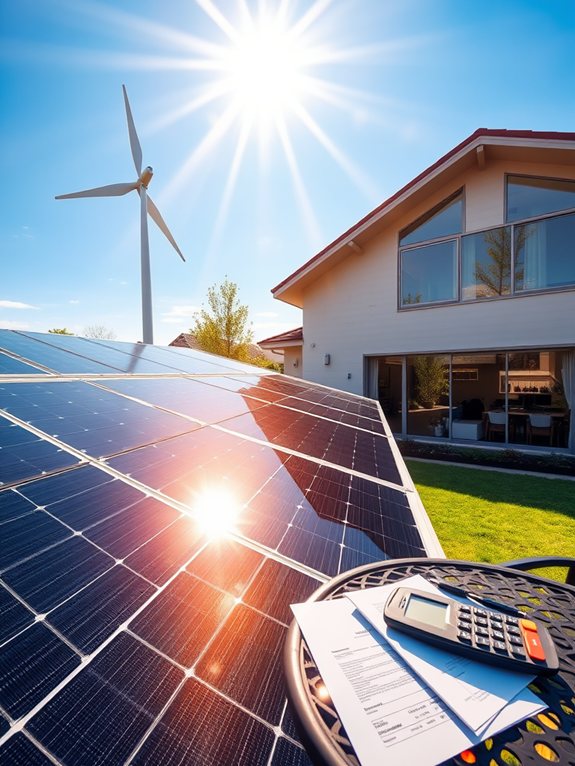You’ll enhance tax benefits by acting promptly to secure the 30% federal tax credit for solar and wind installations at your primary or secondary residence. You must own the system through direct purchase or financing, and obtain utility Permission to Operate before claiming credits via IRS Form 5695. State-level incentives can stack supplementary savings through exemptions, rebates, and financing programs. Strategic planning across federal, state, and local programs reveals the highest potential returns.
Key Takeaways
- Act before December 2025 to secure the full 30% federal tax credit on solar and wind installations at your primary or secondary residence.
- Purchase or finance your renewable system directly, as leases and power purchase agreements do not qualify for federal credits.
- Document all installation costs and obtain utility Permission to Operate before filing IRS Form 5695 for tax credit claims.
- Check state-specific incentives like New York’s 25% credit or California’s PACE financing to stack with federal benefits.
- Ensure system ownership and proper residence qualification before installation to guarantee tax credit eligibility.
Understanding Federal Solar & Wind Tax Credits
While maneuvering through renewable energy incentives can seem complex, the federal solar and wind tax credits offer substantial financial benefits to property owners who install qualifying systems.
Tax credit eligibility requires direct ownership through purchase or loan financing, as leases and PPAs don’t qualify.
The current 30% credit applies to initial installations at primary or secondary residences, including solar panels, wind turbines, and energy storage systems.
Installation requirements mandate that you receive Permission to Operate from your utility before claiming the credit.
You’ll need to document costs using IRS Form 5695, and unused credits can roll forward if your tax liability is insufficient.
State-Level Renewable Energy Incentives
Beyond federal incentives, states offer diverse financial benefits to accelerate renewable energy adoption. You’ll find extensive state incentives including tax exemptions, rebate programs, and specialized initiatives. Key offerings include sales and property tax exemptions in Colorado and Maryland, plus New York’s 25% tax credit up to $5,000.
| State | Tax Benefits | Rebate Programs |
|---|---|---|
| CA | PACE financing | SGIP battery storage |
| CO | 100% sales tax exemption | CORE 25% solar rebate |
| MD | Property tax exemption | $1,000 residential rebate |
| NY | 25% tax credit | NY-Sun $0.20/watt |
| IL | Net metering | Solar for All program |
These state-level programs greatly reduce your renewable energy investment costs while maximizing long-term savings through performance incentives and net metering benefits.
Key Deadlines for Maximum Tax Benefits
Understanding the critical tax credit deadlines can greatly impact your renewable energy savings. Your installation timeline directly affects credit eligibility, with 2025 offering the last opportunity to secure the full 30% federal tax credit before the phase-down begins.
Key deadlines to enhance your benefits:
- Complete installations by December 2025 to qualify for the 30% credit
- File Form 5695 by April 15 of the year following your installation
- Document system costs and Permission to Operate (PTO) date for IRS verification
You’ll need ownership of the system and a qualifying residence to claim credits.
Battery storage supplements follow the same timeline when integrated with existing solar installations.
Commercial vs. Residential Energy Incentives
As federal and state governments expand renewable energy adoption, commercial and residential incentives follow distinctly different frameworks to address unique sector needs. You’ll find commercial energy projects receive more complex incentives, including transferable credits and production-based rewards, while residential energy installations focus on straightforward tax credits and utility benefits.
| Feature | Commercial | Residential |
|---|---|---|
| Tax Credit Base | 30% ITC | 30% ITC |
| Size Requirements | >1MW needs wage standards | No size restrictions |
| Credit Transfer | Can sell to third parties | Non-transferable |
| Extra Benefits | Bonus credits up to 60% | Net metering available |
The key difference lies in scalability – commercial projects can stack multiple incentives, while residential installations benefit from simpler implementation and maintenance requirements.
Smart Strategies to Stack Multiple Benefits
While maximizing renewable energy tax benefits requires careful planning, strategic stacking of multiple incentives can dramatically improve returns. By combining stackable bonuses for low-income communities, domestic content, and energy communities, you can elevate tax credits up to 70%.
- Layer transferable credits with direct pay options in qualifying areas to optimize cash flow without complex tax equity structures.
- Enhance benefits by siting projects in designated low-income or tribal lands where multiple incentives overlap.
- Coordinate regional resource complementarity to improve project viability while capturing stacked incentives.
Consider fine-scale planning with sub-10km resolution data to guarantee ideal placement for both tax benefits and operational efficiency.
Financial Planning for Renewable Energy Projects
Successful renewable energy projects depend on thorough financial planning that integrates multiple data streams and risk factors.
Your cost estimation must analyze CAPEX/OPEX requirements, equipment procurement, and installation expenses while incorporating historical benchmarks and technology price trends.
Conduct extensive risk assessment by evaluating regulatory changes, market volatility, and environmental impacts.
You’ll need to model revenue streams through power curve analysis, PPA agreements, and REC trading opportunities.
Consider financing options including debt-equity combinations and government incentives.
Base your decisions on data-driven metrics: resource availability data, tariff structures, market projections, and proven financial performance benchmarks from existing installations.
Conclusion
Federal and state renewable energy tax credits present significant financial advantages if you’re planning solar or wind installations. You’ll need to act within current deadlines to enhance your benefits, as credit percentages decrease annually. Whether you’re pursuing commercial or residential projects, strategically combining multiple incentives can reduce your initial investment by 30-60%. Careful financial planning and documentation remain crucial for ideal tax benefit realization.


